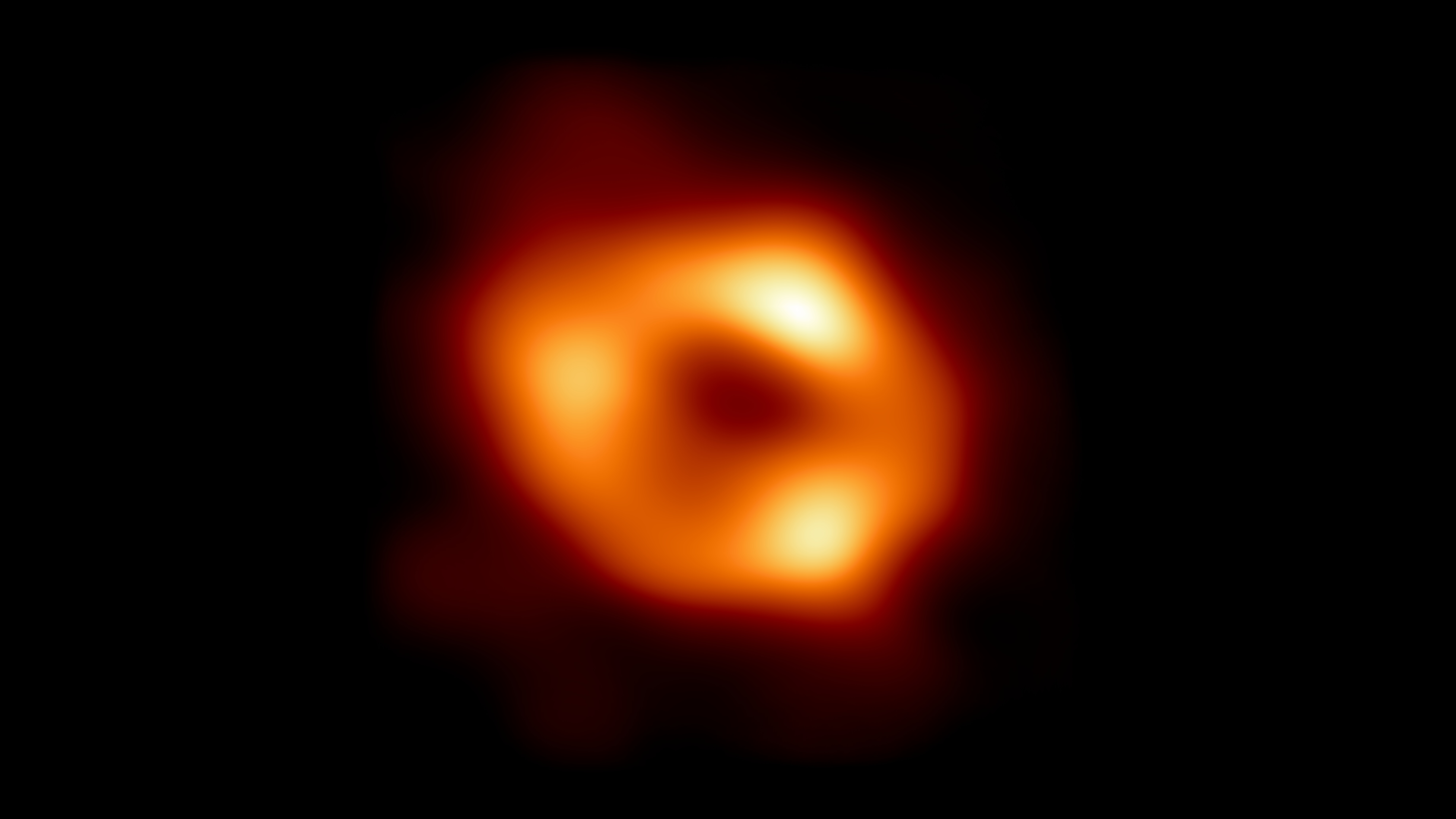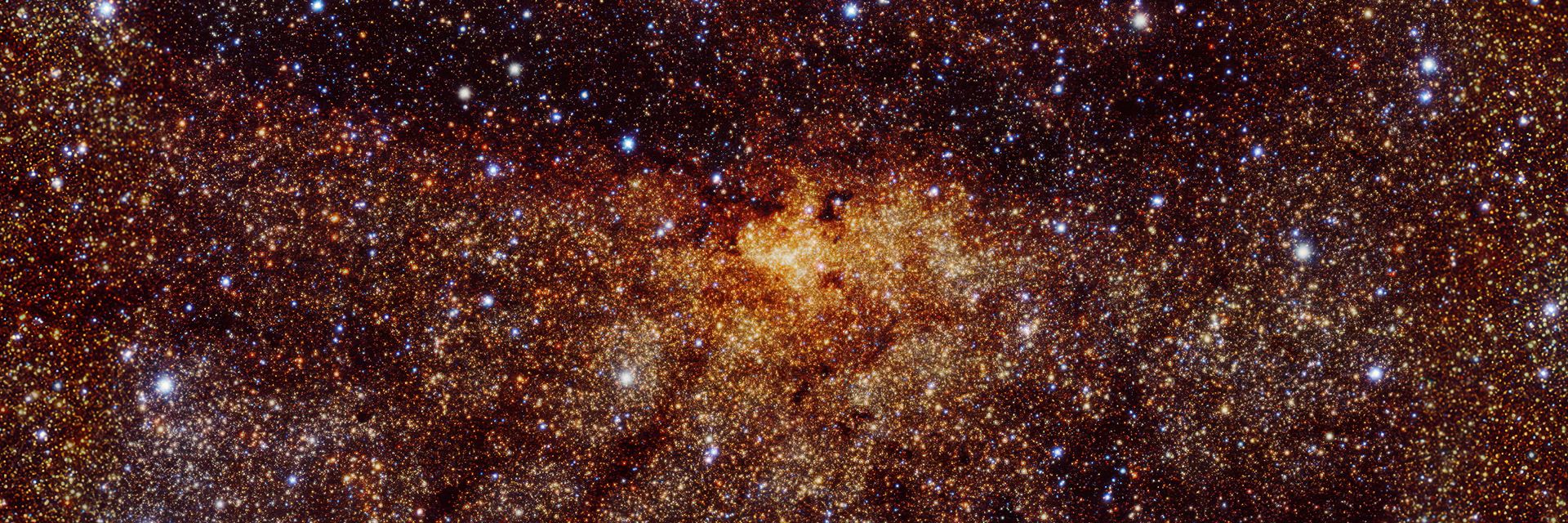In 2022, history was made when an image of the supermassive black hole at the center of our galaxy, the Milky Way, was released to the public. Even more momentous, the discovery confirmed the predictions of Albert Einstein’s theory of general relativity.
◊
It was just over a century ago that the idea of black holes was first conceived. We have Albert Einstein to thank for that, and even he looked at the idea somewhat askance. He didn’t even call them “black holes”; that term was not invented until 1967, when astronomer John Wheeler used it in a paper. To Einstein, they were simply very dense agglomerations of matter. And, troublingly, Einstein’s own theories about gravity fell apart when considering the points in space-time where these “agglomerations” were proposed to exist.
Nonetheless, when he presented his theory in Berlin, in 1915, at the Prussian Academy of Sciences, he included this confounding mystery as part of his paper. (A year later, he published his findings in a book titled Relativity: The Special and the General Theory.) General relativity predicts that there are objects in our Universe that are incredibly small, incredibly dense, and incredibly powerful. They are so dense that no light can escape from them and are therefore invisible to the eye. They can only be detected by the warped light that can be seen appearing around them from stars near and behind these objects.
Einstein’s theory was immeasurably helpful to other astronomers and cosmologists who followed in his wake. But still, there was one enduring problem: How can we visualize a dense, small, massive object that emits no light whatsoever? Can we ever hope to get a picture that reveals what a black hole and its environs look like?
Finally, in 2019, after decades of research, the first image of a supermassive black hole was released to the public. In the heart of the M87 galaxy, over 53 million light-years from Earth, lay a black hole named M87*, whose technology-assisted image stunned the scientific community. But even more excitement was ahead: In 2022, after five years of high-tech data analysis, an image of the supermassive black hole that resides at the heart of our own galaxy, the Milky Way, was published. And it proved Einstein right.
For the latest on the imagery of black holes, check out this episode of MagellanTV's original series Space: The New Frontier.
The Event Horizon Telescope Collaboration Leads the Way
Einstein predicted that black holes would be incredibly dense due to the enormous amount of matter and energy concentrated in a single point. This he called the singularity. He also predicted that they would be incredibly powerful due to the immense gravitational pull that would be exerted on anything nearby. Finally, he predicted that they would be incredibly small because the gravitational pull of a black hole would cause it to collapse in on itself and become ever smaller.
Did you know that black holes make sounds? Because of their emission of radio waves, radio telescopes have been able to pick up audio emanations from black holes. Is this the music of the spheres?
The challenges inherent in viewing black holes only made scientists work harder to solve their mysteries. Since black holes emit no light, regular means of finding objects in the heavens wouldn’t work. But there is material that surrounds a black hole – its halo. Due to the extreme gravity of black holes, everything that’s within their vicinity is inexorably pulled toward it. This includes stars and gas. And both emit visible light, X-rays, and radio waves. By searching for rapidly spinning sources of these emissions, black holes can be targeted.
The search would be much easier if there were a radio telescope large enough to search for tiny but massive objects in deep space around which material is emitting incredible amounts of light, heat, and radio waves. And that’s just the sort of tool astronomers came to believe they needed. So, in 2009, hundreds of scientists affiliated with scores of institutions worldwide came together to work on a solution, which they called the Event Horizon Telescope (EHT) Collaboration.
Starting with eight radio telescopes in six locations, astronomers built on the theory that these terrestrial telescopes could be linked to increase their searching power. The EHT Collaboration says these linked telescopes created “a fundamentally new instrument with angular resolving power that is the highest possible from the surface of the Earth.”
Imaging Galaxy M87’s Galactic Center
After much investigation stretching back decades, astronomers concluded that every galaxy has a black hole at its center. And younger ones, galaxies in earlier stages of development, would have larger, more active black holes. Scientists working with the EHT set their sights on a very distant galaxy, called Messier 87 after its discoverer.
Messier 87, or M87, is a mind-bending 54 million light-years from Earth. Known as a supergiant elliptical galaxy in the constellation Virgo, M87 is larger and brighter – and younger – than our Milky Way. Its galactic center black hole is also larger and more active than ours. Because of its size and the relative brightness of its region, it was selected as the first target for the EHT’s radio telescope array.
Every galaxy theoretically has a centrally located black hole, but there are many more out there than there are galaxies. These others are called “wandering black holes.”
Beginning in 2017, the EHT Collaboration was able to link its eight member telescopes into a virtual, Earth-sized radio telescope that set its focus on the location of the black hole at the center of Messier 87. Once the observations were complete, the data from this project were fed into supercomputers that worked for two years to complete a technologically assisted image of M87’s black hole, which has been given the name M87*. (That symbol is not meant to be an asterisk but a sign standing for “star.” It can be confusing, as the black hole is not a star but a star-devourer.)

This is the first-ever visual image of a black hole, M87*, made public in 2019. (Source: EHT Collaboration)
Even so, the picture doesn’t reveal the actual appearance of the black hole, which appears featureless at the center of the image. Rather, it shows the black hole’s shadow. This shadow can be seen as a “doughnut” composed of light emitted by the stars and gases that rapidly rotate around the hole at a velocity approaching the speed of light.
The Black Hole in Our Back Yard
Even before M87*’s image was published, work was underway to begin the observation process for our galaxy’s central black hole. The Milky Way is a spiral galaxy that resembles a spinning pinwheel. Earth is located on one of the “arms” of the wheel, 25,640 light-years from the Milky Way’s galactic center. This distance, of course, is dwarfed by the 54 million light-years that separate us from M87*. But the relative nearness makes our own black hole that much more intriguing to study.
In 2020, researchers Andrea Ghez and Reinhard Genzel were awarded the Nobel Prize in Physics for years of research that led to their discovery of activity in this region that was consistent with the presence of a black hole. But, of course, they did not have the technological capability actually to view the hole, only its effects.
Ghez and Genzel’s work was instrumental in showing the EHT team where to train their radio telescopes. So, in 2017, the team began its observation of this spot in space, located in the sky at the border of the constellation Sagittarius and its neighbor Scorpius. The specific spot is called Sagittarius A, which refers to the brightest sector of the constellation.
That led to the purported black hole being named Sagittarius A* (commonly abbreviated as SgrA*), using the same nomenclature as M87*. Once again, the EHT Collaboration fed its data into two supercomputers, where calculations proceeded for a total of five years before May 2022, when the new image of the previously unseen black hole was released.

First image of Sagittarius A*. Note its many similarities to M87*. (Source: EHT Collaboration)
What We’ve Learned, and What’s Ahead
There’s more to this story than just the technological advances that have allowed astronomers to image black holes. Einstein’s theories about the properties of a black hole and its behavior have been confirmed. He predicted that black holes would attract matter that in turn would revolve around it at close to the speed of light. He also posited that gravity is matter warping space-time, which has been shown by how light around the images of the black holes is bent, warped, and magnified; even light from stars behind the black holes shows up in these images.
There are other correlations between Einstein’s theories and the black hole images. Scientists are excited by these proofs of Einstein’s 108-year-old paper on general relativity and his discussion of how gravity would work in “very dense agglomerations of matter.” But there’s even more to come. The EHT group has laid out its goals for continuing research. They have added more ground telescopes to their consortium and now have a total of 11 radio telescopes ready to go in their next investigation.
These new telescopes will be key in upcoming research and observation. First, they will allow much more image detail to clear up the fuzziness of the current images. In particular, SgrA*’s very rapid spinning close to the hole’s event horizon – approaching the speed of light – will be able to be captured in high definition.
Second, the EHT team will eventually be able to make movies of black holes. This will be instrumental to learning even more about the workings of a black hole. Goals of the future observations include a better understanding of gravity, and even the role of these black holes in the evolution of galaxies.
Virtually every year brings scientific breakthroughs on how our Milky Way developed, even how our star, the Sun, came to rest on a spoke of the vast pinwheel of our galaxy. Someday we may even have radio telescopes in space; then we will be able to better image just how black holes “swallow” matter and spit out quasars. Astronomers are excited about the future promise of the EHT team’s mission, and there are certain to be many more surprises out there just waiting for discovery.
Ω
Kevin Martin is Senior Writer for MagellanTV. He writes on various topics, including outer space, the fine arts, and modern history. He has had a long career as a journalist and communications specialist with nonprofit and for-profit organizations. He resides in Glendale, California.
Title Image: This image of the Sagittarius A region of our Milky Way is home to the black hole named Sagittarius A*, or SgrA*.

